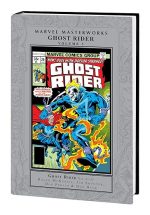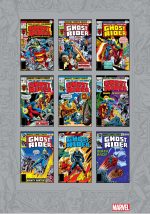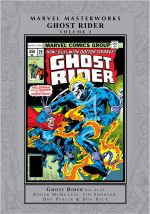


By Jim Shooter, Roger McKenzie, Gerry Conway, Don Glut, Don Perlin. Jim Starlin, Don Heck, Gil Kane, Tom Sutton & various (MARVEL)
ISBN: 978-1-3029-2214-6 (HB/Digital edition)
At the end of the 1960s American comic books were in turmoil, much like the youth of the nation. Superheroes had dominated for much of the previous decade; peaking globally before explosively falling to ennui and overkill. Established genres such as horror, war, westerns and science fiction returned, fed by contemporary events and radical trends in movie-making where another, new(ish) wrinkle had also emerged: disenchanted, rebellious, unchained Youth on Motorbikes seeking a different way forward.
Green Lantern/Green Arrow, Jack Kirby’s Jimmy Olsen, Captain America and many others all took the Easy Rider option to boost flagging sales (and if you’re interested, the best of the crop was Mike Sekowsky’s tragically unfinished mini-masterpiece of cool Jason’s Quest in Showcase). Over at Marvel – a company still reeling from Kirby’s defection to DC/National in 1970 – canny Roy Thomas green-lighted a new character who combined the freewheeling, adolescent-friendly biker-theme with the all-pervasive supernatural furore gripping the entertainment fields.
Back in 1967, Marvel published a western masked hero named Ghost Rider: a shameless, whole-hearted appropriation of the cowboy hero creation of Vince Sullivan, Ray Krank & Dick Ayers (for Magazine Enterprises from 1949 to 1955), who utilised magician’s tricks to fight bandits by pretending to be an avenging phantom of justice.
Scant years later, with the Comics Code prohibition against horror hastily rewritten – amazing how plunging sales can affect ethics – scary comics came back in a big way. A new crop of supernatural superheroes and monsters began to appear on the newsstands to supplement the ghosts, ghoulies and goblins already infiltrating the once science-only scenarios of the surviving mystery men titles.
In fact, softening the Code ban resulted in such an avalanche of horror titles (new material and reprints from the first boom in the 1950s), in response to the industry-wide down-turn in superhero sales, that it probably caused a few more venerable costumed crusaders to – albeit temporarily – bite the dust.
Almost overnight, nasty monsters became acceptable fare for four-colour pages and whilst a parade of pre-code reprints made sound business sense, the creative aspects of the fascination in supernatural themes was catered to by adapting popular cultural icons before risking whole new concepts on an untested public.
As always in entertainment, the watchword was fashion: what was hitting big outside comics was incorporated into the mix as soon as possible. When proto-monster Morbius, the Living Vampire debuted in Amazing Spider-Man #101 (cover-dated October 1971) and the sky failed to fall in, Marvel moved ahead with a line of shocking superstars – beginning with a werewolf and a vampire – before broadening the scope with a haunted biker to tap into both Easy Rider’s freewheeling motorcycling chic and the prevailing supernatural zeitgeist.
Preceded by western hero Red Wolf in #1 and the aforementioned Werewolf by Night in #2-4, the all-new Ghost Rider debuted in Marvel Spotlight #5 (August 1972) and this sturdy hardback and equivalent digital compendium collects a third heaping helping of his flame-filled early exploits: specifically Ghost Rider #21-35, plus added attraction Marvel Premiere #28, spanning December 1976 to April 1979, and is preceded by an informative Introduction from Ralph Macchio.
What Has Gone Before: Carnival trick cyclist Johnny Blaze sells his soul to the devil in an attempt to save his foster-father Crash Simpson from cancer. As is the way of such things, Satan follows the letter but not spirit of the contract and Simpson dies anyway. When the Dark Lord later comes for his prize, Blaze’s beloved virginal girlfriend Roxanne Simpson intervenes. Her purity prevents the Devil from claiming his due and, temporarily thwarted, Satan spitefully afflicts Johnny with a body that burns with the fires of Hell every time the sun goes down…
After dancing with the Devil and assorted demons for months, and even dabbling with team superheroics on the Champions, Johnny has moved to Hollywood and works as stuntman on the Stuntman TV show: a hazardous gig that has brought him into a romantic dalliance with starlet Karen Page, a team-up with Daredevil and many clashes with supervillains.
As the action opens in GR #21’s ‘Deathplay!’, Gerry Conway, Kil Kane & Sam Grainger build on the trend as manic hireling The Gladiator attacks the Delazny Studio seeking a deadly weapon left by a sinister hidden foe.
After spectacularly repelling the armoured assassin, Blaze does a little digging into the studio and its staff only to clash with another veteran villain – The Eel, abruptly reinforced by Gladiator seeking a rematch. Thrashing them both only gets him in more trouble with the cops and – on the run again – he finally faces the criminal mastermind who has orchestrated many months of woe and learns ‘Nobody Beats the Enforcer!’ (Conway, Don Glut, Don Heck & Keith Pollard). The ganglord has his fingers dug deep into the studio and seeks ultimate power in LA, but somehow Blaze is always in his way, such as here, foiling the costumed killer’s attempt to steal a deadly ray concealed in a ring.
Attempts to further integrate Ghost Rider with mainstream Marvel continuity intensify with the arrival of new scripter – and actual motorbike afficionado – Jim Shooter. With Dons Heck and Newton illustrating, ‘Wrath of the Water Wizard!’ sees the embattled biker battling a hydrokinetic hoodlum at the Enforcer’s behest, only to be betrayed and beaten in anticipation of a blockbusting clash in Shooter, Heck & Dan Green’s ‘I, The Enforcer…!’
Cover-dated August 1977, Ghost Rider #25 presaged a return to wandering ways as Shooter, Heck & Tony DeZuñiga’s ‘Menace is a Man Called Malice!’ finds the infernal antihero implicated in an arson attack on a wax museum before battling a high tech madman. Blaze’s diabolical overreaction in victory signalled dark days ahead…
Don Perlin began his long association with the Spirit Cyclist in #26 as ‘A Doom Named Dr. Druid!’ (words by Shooter & inks by Grainger) as recently-revived and revised proto Marvel superhero Anthony Druid (who as Dr. Droom actually predates Fantastic Four #1) hunts a satanic horror and attacks the Ghost Rider. Only after beating the burning biker does the parapsychologist learn the dreadful mistake he’s made, but by then Blaze’s secret is exposed, his Hollywood life ruined and the end of an era looms…
Back on the road again Johnny encounters two fellow travellers, aimless and in trouble when he pals up with disgruntled former Avengers Hawkeye and time-displaced Matt Hawk – The Two-Gun Kid. Crafted by Shooter, Perlin & Green ‘At the Mercy of the Manticore!’ sees Blaze save the heroes from The Brand Corporation’s bestial cyborg monstrosity, but drive them away with his demonic other half’s growing propensity for inflicting suffering…
Still roaming the southern deserts, Blaze is targeted once again by his personal Captain Ahab in ‘Evil is the Orb!’ (Roger McKenzie, Perlin, Tom Sutton, Owen McCarron & Pablo Marcos). His vengeance-crazed rival abducts Roxie and mesmerises a biker gang to do his dirty work but hasn’t reckoned on an intervention by Blaze’s buddy Brahma Bill…
What seemed an inevitable team-up at last occurred in #29 as “New York Tribe” McCarron, DeZuñiga, & Alfredo Alcala augment McKenzie & Perlin for a saga of sorcerous subterfuge as Johnny Blaze is abducted and inquisition-ed by Doctor Strange. Sadly, it’s all a trick by the Mage’s greatest foe who turns Ghost Rider into a ‘Deadly Pawn!’, rigging a murderous retaliation and death duel between ‘The Mage and the Monster!’ as delivered by McKenzie, Perlin & Jim Mooney.
The clash concluded in an extreme expression of ‘Demon’s Rage’ (#31, with illustrator Perlin co-plotting with McKenzie and Bob Layton inking) as the diabolical scheme is exposed and expunged just in time for the fugitive Johnny Blaze to be captured by a mystical Bounty Hunter…
A story tragically similar to Blaze’s own unfolds in McKenzie, Perlin & Rick Bryant’s ‘The Price!’ before Blaze postpones his dark destiny yet again, only to plunge into a super-science hell to contest a medley of western biker and dystopian tropes run amok in ‘…Whom a Child Would Destroy!’ With both chapters uniquely enhanced by an all-Perlin art job, the mutagenic tragedy catastrophically concludes with ‘The Boy Who Lived Forever!’ before this collection closes with a long-deferred, primal thrill-ride.
Commissioned years earlier, ‘Deathrace!’ is a true Jim Starlin gem with Death and the Devil battling our hero in a war of wheels and will, with Steve Leialoha and pals updating and embellishing what we’d call today a Grindhouse shocker…
A big bonus section opens with another, much reprinted yarn. Courtesy of Bill Mantlo, Frank Robbins & Steve Gan is an attempt to create a team of terrors long before its time. Marvel Premiere #28 (February 1976) introduced the initial iteration of The Legion of Monsters in ‘There’s a Mountain on Sunset Boulevard!’. When an ancient alien manifests a rocky peak in LA, the Werewolf by Night Jack Russell, the macabre Man-Thing, current Hollywood stuntman/Ghost Rider Johnny Blaze and living vampire Morbius are irresistibly drawn into a bizarre confrontation which could have resulted in the answer to all their wishes and hopes, but instead only leads to destruction, death and deep disappointment…
With covers by Jack Kirby, Frank Giacoia, Al Milgrom, John Romita Sr., Steve Leialoha, Kane & Dave Cockrum, George Pérez & Rudy Nebres, Sal Buscema, Ernie Chan, Rich Buckler, Robbins, Pollard, Layton, Bob Budiansky, Bob Wiacek, Perlin, and Nick Cardy, other assets include a June 1978 house ad for all of Marvel’s supernatural series, original art pages and covers by Kirby, Romita Sr., DeZuñiga, Perlin & Alcala and Chan, as well as fascinating art edits by Milgrom & Michael Netzer to Starlin’s ‘Deathrace!’ story and the unused cover he originally drew for it.
These tales return Ghost Rider to his roots, and imminent threat of the real-deal Infernal Realm: portraying a good man struggling to save his soul from the worst of all bargains – as much as the revised Comics Code would allow – so brace yourself, hold steady and accept no supernatural substitutes…
© 2021 MARVEL.
